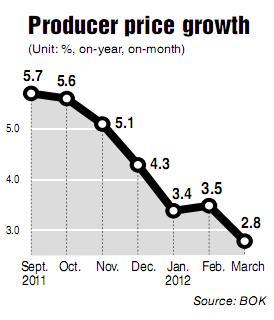South Korea’s producer price growth decelerated to a two-year low in March from the year earlier mainly due to slower price gains in global crude prices, the central bank said Monday.
The producer price index, a barometer of future consumer inflation, gained 2.8 percent last month from a year ago, falling from 3.5 percent on-year growth in the previous month, according to the Bank of Korea. The on-year gain is the lowest since 2.6 percent growth reported for March 2010.

Producer prices also dipped 0.6 percent from the previous month, compared with an on-month increase of 0.7 percent in February.
The slower gain last month was largely attributed to the growth decrease in crude prices and public utility fees. The price of Dubai crude averaged $122.5 in March, up 5.4 percent from the previous month.
“A slowdown in producer prices is expected to exert positive influence on domestic consumer prices,” the BOK said.
Prices for manufactured goods such as refined petroleum and chemical products gained 0.7 percent on-month, while utility fees and transportation costs edged up 0.4 percent and 0.2 percent, respectively. Farm and fisheries product prices moved up 1.4 percent.
Compared with the previous year, producer prices for manufactured goods gained 3.1 percent in March, with numbers for utility charges and transportation services gaining 10.8 percent and 1.3 percent, each.
Prices for farm and fisheries products contracted 3.1 percent vis-a-vis March 2011.
The central bank, meanwhile, said there have been few benefits felt from the free trade agreement with the United States that went into effect in mid-March.
Besides the slower pace of growth for crude prices, the move to lower individual consumption tax on cars with engine capacity of 2,000cc and higher, helped limit price gains compared to the year before.
The BOK predicted the full impact of the FTA with the United States should start to materialize in April and May, influencing overall producer prices. (Yonhap News)
The producer price index, a barometer of future consumer inflation, gained 2.8 percent last month from a year ago, falling from 3.5 percent on-year growth in the previous month, according to the Bank of Korea. The on-year gain is the lowest since 2.6 percent growth reported for March 2010.

Producer prices also dipped 0.6 percent from the previous month, compared with an on-month increase of 0.7 percent in February.
The slower gain last month was largely attributed to the growth decrease in crude prices and public utility fees. The price of Dubai crude averaged $122.5 in March, up 5.4 percent from the previous month.
“A slowdown in producer prices is expected to exert positive influence on domestic consumer prices,” the BOK said.
Prices for manufactured goods such as refined petroleum and chemical products gained 0.7 percent on-month, while utility fees and transportation costs edged up 0.4 percent and 0.2 percent, respectively. Farm and fisheries product prices moved up 1.4 percent.
Compared with the previous year, producer prices for manufactured goods gained 3.1 percent in March, with numbers for utility charges and transportation services gaining 10.8 percent and 1.3 percent, each.
Prices for farm and fisheries products contracted 3.1 percent vis-a-vis March 2011.
The central bank, meanwhile, said there have been few benefits felt from the free trade agreement with the United States that went into effect in mid-March.
Besides the slower pace of growth for crude prices, the move to lower individual consumption tax on cars with engine capacity of 2,000cc and higher, helped limit price gains compared to the year before.
The BOK predicted the full impact of the FTA with the United States should start to materialize in April and May, influencing overall producer prices. (Yonhap News)
-
Articles by Korea Herald









![[Kim Seong-kon] Democracy and the future of South Korea](http://res.heraldm.com/phpwas/restmb_idxmake.php?idx=644&simg=/content/image/2024/04/16/20240416050802_0.jpg&u=)








![[KH Explains] Hyundai's full hybrid edge to pay off amid slow transition to pure EVs](http://res.heraldm.com/phpwas/restmb_idxmake.php?idx=652&simg=/content/image/2024/04/18/20240418050645_0.jpg&u=20240418181020)

![[Today’s K-pop] Zico drops snippet of collaboration with Jennie](http://res.heraldm.com/phpwas/restmb_idxmake.php?idx=642&simg=/content/image/2024/04/18/20240418050702_0.jpg&u=)